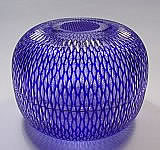As you know, Edo is the old or rather authentic name of present-day Tokyo. This year marks 400th Anniversary of the establishment of Edo Government of Tokugawa Shogun, which started the Edo Period. It was established in 1603 by Shogun Ieyasu who was 63 years old at that time --- a little bit older than me. The Edo period lasted more than 260 years. During most of that period, Japan secluded herself from the rest of the world, but it was a period of peace with no war fought in sharp contrast with some European nations at that time. And it was also a period of high culture with many different kinds of new art bursting forth in different fields. The style of Kiriko on display now is one example of cultural heritage of Edo period.
|
 Japanese glassware has a long history. Indeed, glass trinkets from well over two thousand years ago have been found. And, the production of glass in a sophisticated way was already well established in Japan by the early eighth century. The works on display here, cut glass from Edo are quite modern by comparison, but nonetheless represent a tradition that goes back around 170 years. The Edo Kiriko style, with its distinctive colours and patterns, is highly appreciated in Japan. At the same time, it seems to be appealing to the world. Interestingly, it is said to have somehow even impressed Commodore Perry, commander-in-chief of American Fleet of Black Ships with guns, who came to Japan to demand the opening-up of secluded Japan. It was in 1853, just 150 years ago. |
The style of Edo Kiriko first appeared in 1834. After the Meiji Restoration in 1868, European cut glass methods and equipment were introduced to Japan and adapted by Kiriko craftsmen. In the early part of the last century the craft was developed by further progress in materials and techniques. Over the years technical advances have continued to improve the quality of the glass produced, but the quintessential spirit of Edo Kiriko remains.
In the exhibition, you will be able to recognise at least four different kinds of patterning: nanako, the most typical design in cut glassware which looks, as its name implies, like fish scales; itokiku-tsunagi, which resembles small chrysanthemums scattered across the glass; kome-tsunagi, like grains of rice; and kagome, in the style of basket weave.
I trust that you will find this event enjoyable and inspiring. And I hope very much that you will reflect upon the period of Edo in Japan. Please enjoy yourselves.
Thank you
|


